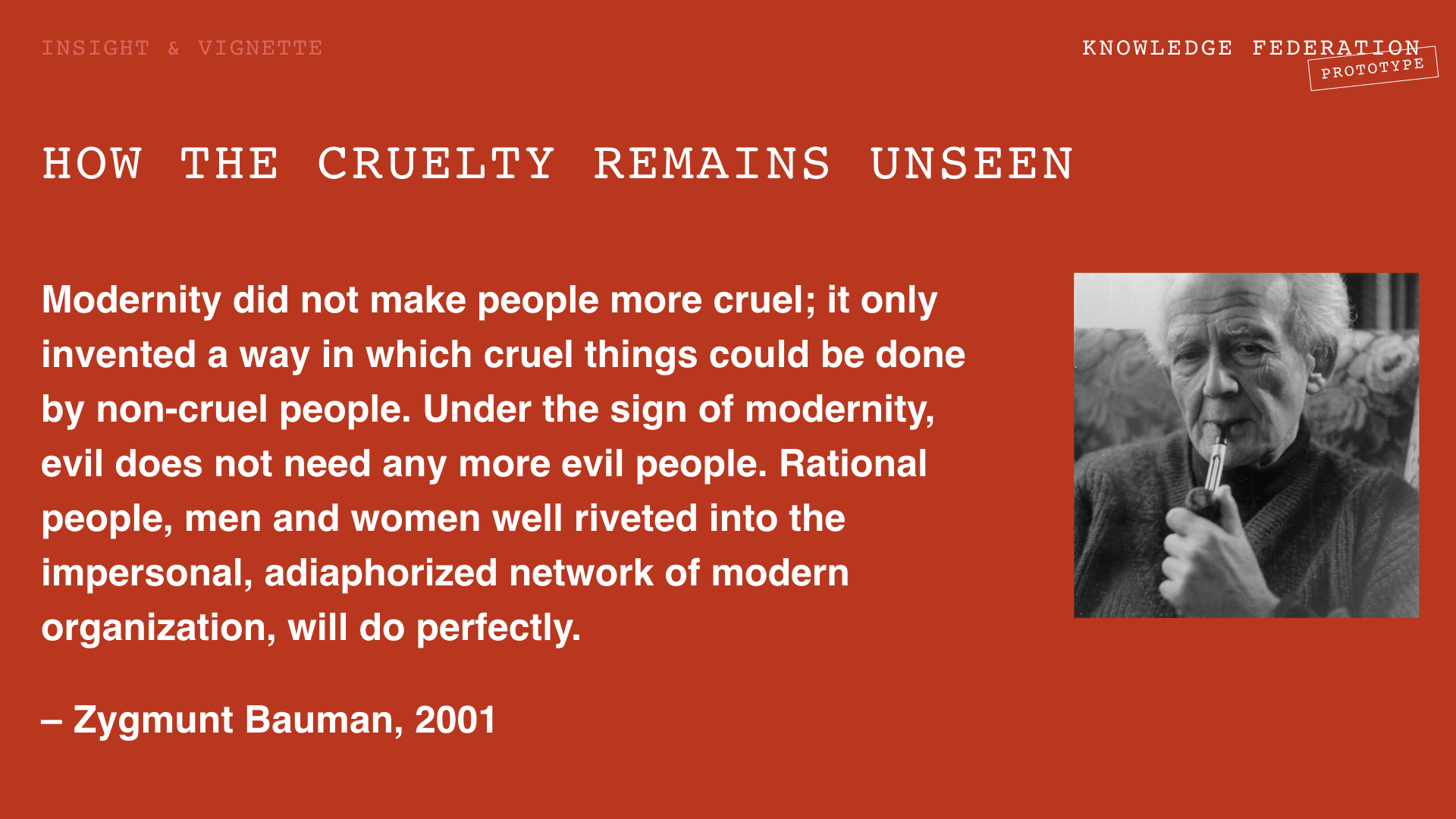Difference between revisions of "Holotopia: Power structure"
m |
m |
||
| Line 51: | Line 51: | ||
<div class="row"> | <div class="row"> | ||
<div class="col-md-3"><h2>Jantsch</h2></div> | <div class="col-md-3"><h2>Jantsch</h2></div> | ||
| − | <div class="col-md-7"><p> | + | <div class="col-md-7"><p>Norbert Wiener here represents cybernetics—whose main message is exactly what the Modernity <em>ideogram</em> depicts symbolically.</p> |
| + | <p>Erich Jantsch is a link between Peccei's project and cybernetics.</p> | ||
| + | <p> See it outlined [http://kf.wikiwiki.ifi.uio.no/CONVERSATIONS#Chomsky-Harari-Graeber here]. </p> | ||
</div> </div> | </div> </div> | ||
Revision as of 13:32, 25 May 2020
H O L O T O P I A: F I V E I N S I G H T S
Power structure
We adopted—and reified—traditional institutions. Here we consider them as gigantic mechanisms, whose function is to turn our daily efforts into socially useful effects. But they don't!
Those systems in which we live and work create for us an ecology, which creates our values, and culture. They need to be seen as power structure—a dictatorial entity of a completely new kind; subverting our efforts at democracy; remaining unseen.
...OR...
When making small technical gadgets, we are ingenious. But those largest and incomparably more important ones—the systems in which we live and work—we don't even look at!
By calling them power structure, we point to this most costly error's most interesting cause: We do ot adapt our institutions to their purpose, because they serve us a different one: They provide a structure within which our various power strifes, both personal and collective, are being played.
A result is that the power structure becomes our enemy. We become our enemy!
Stories
Ferguson
The Ferguson–McCandless–Fuller thread is intended to serve as a parable—showing that for all we know, we may have all the resources we need to take care of the world's issues. The question (answered entirely by the systems in which we live and work) is how we use (or distribute) our resources. See it outlined here and here.
Graeber
What exactly drives our social-systemic evolution? What might be the result?
The Chomsky–Harari–Graeber thread is a suitable parable. It is outlined here.
Bauman
Bauman's observations about how the evil and the cruelty happen in modernity just by everyone "doing his job" is most illuminating here. Even the concentration camp can be seen as a parable for a contemporary efficient organization—where the evil "just happens"...
We extend Bauman's observations into a thread by adding the movie "The Reader" and Joek Bakan's "The Corporation—Pathological Pursuit of Profit and Power" (outlined here).
And now about "The Reader": This movie did not exactly remain unnoticed. It was nominated for the Academy Award as the best film, Kate Winslet got the Academy Award as the best actress. So the interesting thing about this movie is that among so many descriptions and opinions of famous critics etc. on its Wikipedia page, nobody really mentioned what the movie is about.
The point is that we submit to power structure (represented here, again, by a concentration camp) out of a sense of duty. Because we are "good citizens". Or because we are scared. Or (as K.W. said, in her role, because otherwise "there would be chaos". And then when the power structure changes, and the horror of the old one emerges in the light of day—as if waking up from a dream, we look for a culprit. A scapegoat.
The social-psychological dynamic this film (among so many others) is pointing to is of pivotal importance. It must be federated.
A consequence is that we are all very good at perceiving, and confronting, the Hitlers from the past. But what about our contemporary ones?
Joel Bakan's "The Corporation" is offered as a (once again parabolic) example. If you haven't opened the above link, you may do it now, here it is.
Jantsch
Norbert Wiener here represents cybernetics—whose main message is exactly what the Modernity ideogram depicts symbolically.
Erich Jantsch is a link between Peccei's project and cybernetics.
See it outlined here.
Ideogram
The System ideogram suggests that our institutions or more generally (socio-technical) systems, or the power structures, need to be perceived as gigantic mechanisms; and handled as such (adapted to their purpose).
The ideogram also suggests that the power structures form an environment by which our life quality is determined, and in which our human quality grows or devolves.
Keywords
Power structure
The power structure models the intuitive notions "power holder" and "political enemy". While our ethical, legal and political sensibilities are tuned to power structures of the times gone by, completely new are now obstructing our freedom, threatening our future, and demanding attention.
Systemic innovation
Systemic innovation is what must be in place to counteract the power structure, and the devolution it engenders.
Prototypes
The Game-Changing Game
A generic way to change systems. "Empowering the young to co-create their future" is what we, as generation, need to do, isn't it? The Game-Changing Game is exactly that. See it described here.
The Club of Zagreb
When we created The Game, we thought The Club of Rome needed an update—a practical way in which its members, who are in positions of power, can effectively use their power to make a difference there where the difference is to be made. So we created The Club of Zagreb as prototype. See it described here.
Authentic Hercegovina
Out of a number of prototypes that illustrate what systemic innovation might be like in a particular domain of application, and what difference it may make, we present the Authentic Hercegovina prototype as an redesign of the corporation, which empowers small economies and cultures, stimulates cultural exchange, post-war revitalization, and authenticity!It is described here.
Collaborology
Education too, when transformed through systemic innovation can serve a variety of core purposes. Not the least—human development. See our educational prototype here.


